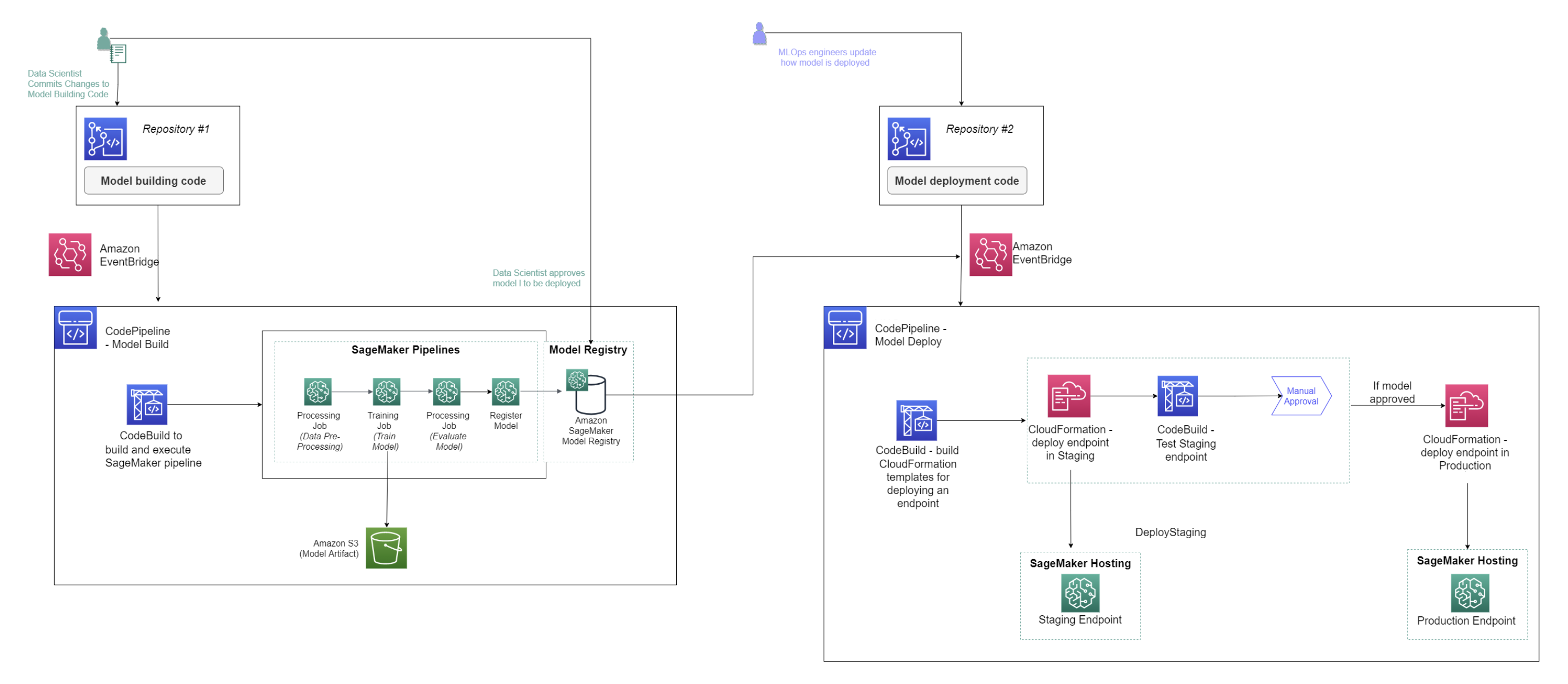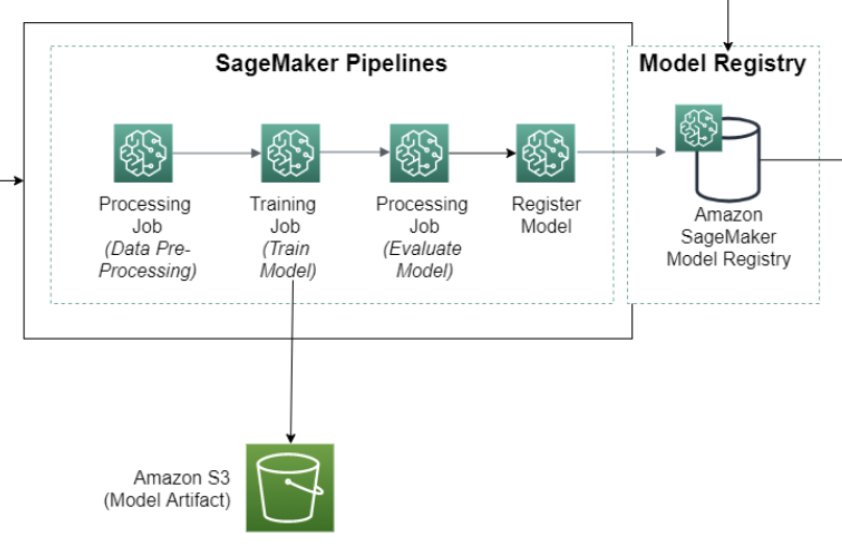What is a SageMaker AI Project?
SageMaker Projects help organizations set up and standardize developer environments for data scientists and CI/CD systems for MLOps engineers. Projects also help organizations set up dependency management, code repository management, build reproducibility, and artifact sharing.
You can provision SageMaker Projects using custom templates that are stored in Amazon S3 buckets, or by using templates from the Amazon Service Catalog or SageMaker AI. For information about the Amazon Service Catalog, see What Is Amazon Service Catalog. With SageMaker Projects, MLOps engineers and organization admins can define their own templates or use SageMaker AI-provided templates. The SageMaker AI-provided templates bootstrap the ML workflow with source version control, automated ML pipelines, and a set of code to quickly start iterating over ML use cases.
When Should You Use a SageMaker AI Project?
Important
Effective September 9, 2024, project templates that use the Amazon CodeCommit repository are no longer supported. For new projects, select from the available project templates that use third-party Git repositories.
While notebooks are helpful for model building and experimentation, a team of data scientists and ML engineers sharing code needs a more scalable way to maintain code consistency and strict version control.
Every organization has its own set of standards and practices that provide security and governance for its Amazon environment. SageMaker AI provides a set of first-party templates for organizations that want to quickly get started with ML workflows and CI/CD. The templates include projects that use Amazon-native services for CI/CD, such as Amazon CodeBuild, Amazon CodePipeline, and Amazon CodeCommit. The templates also offer the option to create projects that use third-party tools, such as Jenkins and GitHub. For a list of the project templates that SageMaker AI provides, see Use SageMaker AI-Provided Project Templates.
Organizations often need tight control over the MLOps resources that they provision and manage. Such responsibility assumes certain tasks, including configuring IAM roles and policies, enforcing resource tags, enforcing encryption, and decoupling resources across multiple accounts. SageMaker Projects can support all these tasks through custom template offerings where organizations use Amazon CloudFormation templates to define the resources needed for an ML workflow. Data Scientists can choose a template to bootstrap and pre-configure their ML workflow.
To get started, we recommend that you create and store custom templates inside an Amazon S3 bucket. Doing so lets you create a bucket in any supported Region for your organization. S3 supports version control, so you can maintain multiple versions of your templates and roll back if necessary. For information about how to create a project from template store in an Amazon S3 bucket, see Using a template from an Amazon S3 bucket.
Alternatively, you can also create custom templates as Service Catalog products and you can
provision them in the Studio or Studio Classic UI under Organization
Templates. The Service Catalog is a service that helps organizations create and
manage catalogs of products that are approved for use on Amazon. For more information
about creating custom templates, see Build Custom SageMaker AI Project Templates – Best Practices
While you can use either option, we recommend that you use S3 buckets over the Service Catalog, so you can create a bucket in supported Regions where SageMaker AI is available without needing to manage the complexities of the Service Catalog.
SageMaker Projects can help you manage your Git repositories so that you can collaborate more efficiently across teams, ensure code consistency, and support CI/CD. SageMaker Projects can help you with the following tasks:
-
Organize all entities of the ML lifecycle under one project.
-
Establish a single-click approach to set up standard ML infrastructure for model training and deployment that incorporates best practices.
-
Create and share templates for ML infrastructure to serve multiple use cases.
-
Leverage SageMaker AI-provided pre-built templates to quickly start focusing on model building, or create custom templates with organization-specific resources and guidelines.
-
Integrate with tools of your choice by extending the project templates. For an example, see Create a SageMaker AI Project to integrate with GitLab and GitLab Pipelines
. -
Organize all entities of the ML lifecycle under one project.
What is in a SageMaker AI Project?
Customers have the flexibility to set up their projects with the resources that best serve their use case. The example below showcases the MLOps setup for an ML workflow, including model training and deployment.

A typical project with a SageMaker AI-provided template might include the following:
-
One or more repositories with sample code to build and deploy ML solutions. These are working examples that you can modify for your needs. You own this code and can take advantage of the version-controlled repositories for your tasks.
-
A SageMaker AI pipeline that defines steps for data preparation, training, model evaluation, and model deployment, as shown in the following diagram.

-
A CodePipeline or Jenkins pipeline that runs your SageMaker AI pipeline every time you check in a new version of the code. For information about CodePipeline, see What is Amazon CodePipeline. For information about Jenkins, see Jenkins User Documentation
. -
A model group that contains model versions. Every time you approve the resulting model version from a SageMaker AI pipeline run, you can deploy it to a SageMaker AI endpoint.
Each SageMaker AI project has a unique name and ID that are applied as tags to all of the SageMaker AI and Amazon resources created in the project. With the name and ID, you can view all of the entities associated with your project. These include:
-
Pipelines
-
Registered models
-
Deployed models (endpoints)
-
Datasets
-
Service Catalog products
-
CodePipeline and Jenkins pipelines
-
CodeCommit and third-party Git repositories
Do I Need to Create a Project to Use SageMaker AI Pipelines?
No. SageMaker pipelines are standalone entities just like training jobs, processing jobs, and other SageMaker AI jobs. You can create, update, and run pipelines directly within a notebook by using the SageMaker Python SDK without using a SageMaker AI project.
Projects provide an additional layer to help you organize your code and adopt operational best practices that you need for a production-quality system.